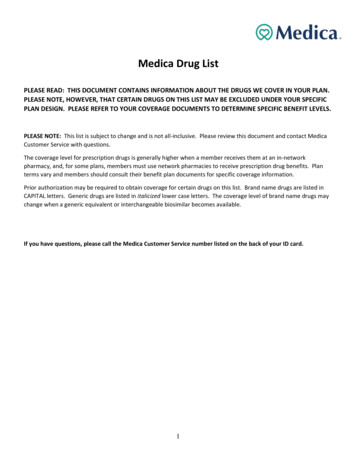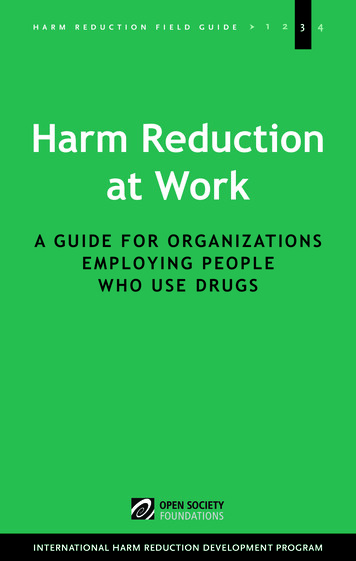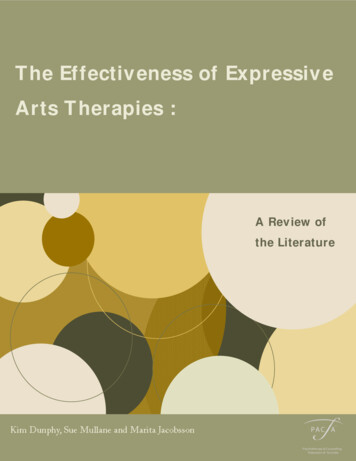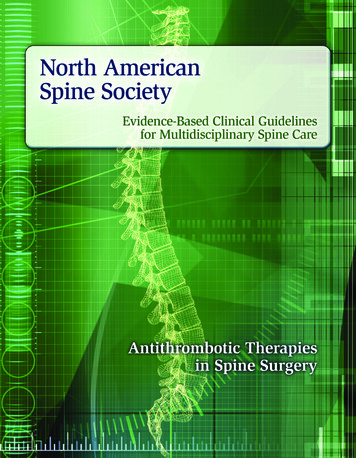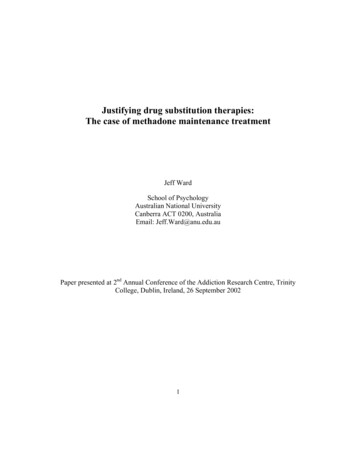
Transcription
Justifying drug substitution therapies:The case of methadone maintenance treatmentJeff WardSchool of PsychologyAustralian National UniversityCanberra ACT 0200, AustraliaEmail: Jeff.Ward@anu.edu.auPaper presented at 2nd Annual Conference of the Addiction Research Centre, TrinityCollege, Dublin, Ireland, 26 September 20021
IntroductionSome time ago, I was told the story of a meeting that took place in a local community, thepurpose of which was to decide whether a methadone clinic should be established there. At thismeeting, members of the relevant government health authority and medical practitioners wantingto establish the clinic tried to alleviate community concerns about the clinic by talking about theevidence in favour of methadone maintenance and responding to concerns raised during themeeting. Concerns were raised about the possibility of the clinic attracting more heroin users tothe area, the effects on local business, the risks associated with discarded needle and syringes, andso on. After long discussion, it appeared that the majority of the audience were convinced thatmethadone maintenance was an effective treatment for heroin dependence and their fears wereassuaged by the arguments that they had heard. Just as the meeting was drawing to a close, onemember of the audience raised her hand and wanted to know if methadone was a drug just likeheroin. When it was answered, somewhat reluctantly by my informant that, yes, methadone was adrug that acted in ways similar to heroin, the mood of the meeting immediately changed, and,within a short period of time, it became clear that if methadone was a drug just like heroin, thenpeople didn’t want a methadone clinic in their community. What is more, they couldn’t see howgiving people a drug that was just like heroin that they would then be dependent on would be ofany benefit anyway.This story brings into focus the sometimes very different perspectives of those involved in drugtreatment and policy formation and members of the concerned community. In many countriesaround the world the recent focus of academics, clinicians and policy makers has been onreducing the harms associated with the use of psychoactive drugs and not necessarily oneliminating the drug use or dependence itself (although it does not preclude this goal). Those whoare opposed to the harm reduction approach see the drug use as the major harm and expect thattreatments be focussed on abstinence from all drugs, including, in the case of heroin dependence,methadone. From this perspective, methadone maintenance is often said to simply substitute onedrug for another.Despite having been implemented and evaluated for nearly 40 years, methadone maintenanceremains a controversial treatment. It is important then to be clear about what the rationale formethadone maintenance is and to evaluate the treatment in these terms, in the light of theaccumulated research literature. However, I will argue that it is also important to examine theviability of the position of the critics of methadone maintenance treatment in the light of therelevant literature on opioid dependence, methadone maintenance treatment and the alternativetreatments for heroin dependence, such as detoxification and drug-free residential treatment.2
In considering these questions, I will argue that the appropriate comparison condition to theoutcomes achieved by methadone maintenance and these other treatments is what would happenin the absence of treatment (Gerstein & Harwood, 1990) not some ideal state wherein all theindividuals currently dependent on heroin would suddenly cease heroin use (Hall, 1993).There have historically been two major rationales put forward for methadone maintenancetreatment. The first was put forward by Dole and Nyswander (1965), who argued, on the model ofdiabetes mellitus, that long term exposure to an opioid, such as heroin, results in a “metabolicdeficiency” that requires long term administration of a substitution opioid to manage it. Thesecond, and more widely accepted, rationale for methadone maintenance treatment arose in the1980s, after the widespread proliferation of and alarm about heroin use in many Westerncountries. This rationale is usually, but not always, associated with a harm reduction approach tothe management of drug problems. According to this point of view, methadone maintenance isjustified because the benefits that accrue from the treatment outweigh the risks associated with itfor both the recipient of treatment and the community.In the sections that follow, I will review evidence and arguments pertinent to an evaluation of thecriticisms and justifications for methadone maintenance treatment. In doing so, I will begin byoutlining the major features of opioid dependence and the harms associated with it. Then, after abrief history of methadone maintenance treatment, I will evaluate the criticism that it simplyreplaces dependence on one drug with dependence on another. The bulk of the remainder of thepaper evaluates the evidence concerning the risks and benefits of methadone maintenancetreatment, including a consideration of the most effective model of treatment delivery. In doingso, I will establish that methadone maintenance treatment is an effective treatment for heroindependence in that it reduces heroin use, crime, HIV infection, and mortality. However, it is not apanacea for resolving all of the problems associated with heroin use. It does not prevent thespread of hepatitis C, and it does not lead to improvement in all individuals who present fortreatment, although it does lead to improvement in the majority of those who present.Opioid dependenceThe most commonly used illicit opioid in most countries around the world is heroin. Of thosewho use this drug, approximately one-quarter develop dependence (Anthony & Helzer, 1995).After becoming dependent, a typical picture emerges of daily heroin-use, interrupted by periodsof detoxification and imprisonment, but with most individuals returning soon after to daily use.This use is continued despite a range of serious legal, health, financial and interpersonal problemsthat are typically associated with daily heroin use.3
Most heroin dependent individuals present for treatment as result of pressure from family andfriends, or because they have been arrested for a drug-related offence (Gerstein & Harwood,1990). In the short term, only a small proportion achieve abstinence as a result of treatment. Overa 20 year period, about one-third of those who enter treatment and are then followed will achieveabstinence, which is approximately the same proportion as those who will die in the same period(Goldstein & Hen-era, 1995; Hser, Anglin, & Powers, 1993). The remaining third who continueto use heroin cycle through prisons, treatment programs and daily heroin use well into their 40sand 50s. When not in prison or attending a treatment program, these people use heroin on a dailybasis about 40-60% of the time (Maddux & Desmond, 1992).Illicit heroin use is associated with a range of health and social problems for both the communityand the user. People who use heroin are at increased risk of death from overdose, violence, viralinfections and alcohol-related morbidity (alcohol dependence being a common comorbidcondition in this population; Goldstein & Herrera, 1995; Haastrup & Jepsen, 1984; Hser et al.,1993; Joe & Simpson, 1987;Perucci, Davoli, Rapiti, Abeni, & Forastiere, 1991; Perucci, Forastiere, Rapiti, Davoli, &. Abeni,1992). While tobacco and alcohol are the major causes of drug-related morbidity and mortality,among young adults, opioids are most prominent as causing drug-related deaths. In Australia, forexample, death by opioid overdose is a major cause of death among young adults (Laslett &Rumbold, 1998), Death from overdose and injection-related viral infections is less likely amongindividuals who ingest heroin intranasaliy or by smoking than among those who inject it. Amongthose who do inject, heroin users act as an important host population for hepatitis B and C andHIV (Crofts, Thompson, & Kaldor, 1999). People who use heroin are also responsible for asignificant proportion of criminal offences, which they commit in order to support the purchase ofheroin (Hall, Bell, & Carless, 1993).Methadone and Methadone Maintenance TreatmentMethadone is a synthetic opioid substance that has effects in human beings similar to heroin.However, unlike heroin, methadone is easily absorbed from the gut and so can be taken orally,whereas heroin is usually injected. Once absorbed via the gut, methadone has a relatively longelimination half-life (approximately 24-36 hours), making it particularly suitable for managingwithdrawal from heroin, which has a much shorter elimination half-life (3-6 hours). As early as1949, research conducted in the United States identified methadone as a useful agent fordetoxifying people addicted to heroin (Joseph, Stancliff, & Langrod, 2000). However, it wasn’tuntil 1964, that Vincent Dole and Marie Nyswander conducted clinical research in New York Cityto identify a suitable replacement for heroin that methadone was used for longer term treatment(Courtwright, Joseph, & Des Jarlais, 1989; Joseph et al., 2000).4
After trying various opioid substances as heroin substitutes, Dole and Nyswander discovered thatthe most clinically useful drug that suited the purposes of a maintenance treatment program wasmethadone. The long elimination half-life meant that patients could be dispensed methadone oncea day, compared with several times a day in the case of drugs such as morphine and heroin. Theoral mode of administration had a number of attractive features associated with it. It obviated theneed for injection, but more importantly, it meant that the rapid intoxication experienced after theinjection of heroin could be avoided, because when taken orally, methadone is absorbed slowlyinto the bloodstream. Furthermore, once the person was stabilised on methadone, they appearednot to experience any significant intoxication, Once the successful results of an early series ofcases was published (Dole & Nyswander, 1965), followed by further reports of treatment success(Dole, Nyswander, & Wamer, 1968; Dole et al., 1969), methadone maintenance treatment wasadopted widely in the United States and was soon established in other countries, such as Australiaand the United Kingdom (Zador, 2001; Caplehom & Batey, 1992). However, this initialenthusiasm was soon tempered by criticisms of the treatment that it medicated the disaffected andsimply substituted one drug for another (e.g. Nelkin, 1973).In their rationale for methadone maintenance treatment Dole and Nyswander viewed opioiddependence as ‘a physiological disease characterised by a permanent metabolic deficiency’ whichwas best treated by administering ‘a sufficient amount of drug to stabilise the metabolicdeficiency’ (Dole & Nyswander, 1965). Stabilisation was achieved by providing high or‘blockade’ daily doses of oral methadone, which prevented withdrawal symptoms, removed thecraving for heroin, and blocked its euphoric effects if the person injected heroin. While patientswere maintained on methadone, they could also take advantage of the rehabilitative services thatwere an integral part of the program (Dole & Nyswander, 1967). The key features of the Dole andNyswander formulation then were long-term treatment, high doses of methadone and acomprehensive set of psychological and social services to assist the person to reintegrate intomainstream society.In the process of the popularisation of methadone maintenance in the United States, the treatmentunderwent a number of important changes that compromised its effectiveness (Gerstein &Harwood, 1990). Most of these changes were made in response to the criticisms of the Dole andNyswander metabolic deficiency hypothesis which was widely thought to be implausible. As aresult, the treatment goal of many programs shifted from long-term maintenance towardsachieving abstinence from all opioid drugs, including methadone, within a period of a few years.The average dose of methadone also declined from the high doses favoured by Dole andNyswander to the much lower doses that were required to simply avert withdrawal symptoms.Furthermore, as a result of funding cuts, the extent of ancillary services declined.5
More recently, national surveys of treatment practices in the United States (D’Aunno & Vaughn,1992; General Accounting Office, 1990) and literature reviews pertinent to the way methadonetreatment is delivered have recommended changes in treatment practice to bring it back in finewith the original Dole and Nyswander formulation (Gerstein & Harwood, 1990; Institute ofMedicine, 1995; Ward, Mattick, & Hall, 1992). Recent evidence suggests that there is a return tothe original Dole and Nyswander formulation, in using higher methadone doses and having anorientation toward long- rather than short-term treatment (D’Aunno, Folz-Murphy, & Lin, 1999).The evidence concerning the effectiveness of intensive psychosocial services remains mixed anddebate continues on this issue.While many countries adopted a model of methadone maintenance treatment that was based ondaily attendance at a specialist clinic with supervised ingestion of methadone, in the UnitedKingdom, a different model developed which involved prescribing by generalist medicalpractitioners and pharmacy dispensing of both injectable and oral methadone (Zador, 2001).Recent controlled trials in the United States of a similar model developed in the United Statessupport the effectiveness of this model of methadone treatment, at least for patients who areresponding well to treatment (Fiellin et al., 2001; King et al., 2002).Controversies About Methadone MaintenanceDespite the evidence attesting to its effectiveness, there are critics who have strong moralreservations about methadone maintenance treatment. These moral reservations are concernedwith whether it is justifiable to dispense a drug of dependence to drug dependent individuals,especially within the Dole and Nyswander model of long-term maintenance. However, whilethere are still a few who subscribe to the original Dole and Nyswander conceptualisation ofopioid dependence as a metabolic disease (but restated as a long term opioid receptorperturbation; e.g. Dole, 1988; Kreek, 1996), the more usual contemporary justification is apragmatic utilitarian one – methadone maintenance is justified because the benefits far outweighthe risks associated with it.While accepting Hume’s argument that statements about what one ought to do cannot be inferredfrom statements about what is the case. Hall, Ward and Mattick (1998) nonetheless argue thatempirical evidence is relevant to the evaluation of moral principles, as do many modem ethicists(eg. Rachels, 1986). If we begin with the pragmatic utilitarian justification for methadonemaintenance treatment, the role of empirical evidence is very clear. Methadone maintenancetreatment is justified, on utilitarian moral grounds, if the benefits of the treatment to both thepatients and the community outweigh its costs. It is then important to demonstrate that methadonemaintenance treatment reduces the harms associated with dependent heroin use without incurringgreater harms to its recipients and the community.6
Some opponents of methadone maintenance argue that methadone maintenance treatment fails toachieve these goals in that substantial numbers of methadone patients continue to inject illicitdrugs and engage in criminal activity. Research evidence on the outcome of methadonemaintenance is clearly relevant to an evaluation of these competing claims.However, an appraisal of the costs and benefits associated with methadone maintenance treatmentdoes not address the key objection that methadone maintenance is unacceptable because it simply‘replaces one drug of dependence with another’. According to this point of view the only viableoutcome from any treatment for opioid dependence is abstinence from all opioid drugs, includingmethadone. Hall et al. (1998) argue that empirical evidence is also relevant to an evaluation ofthis moral objection for the reason outlined by Kant in the late eighteenth century. If it can beshown that a moral obligation is empirically impossible, or at least extremely difficult to meet,there is a good reason to modify it. The moral claim that abstinence is the only acceptableoutcome for treatments for opioid dependence depends upon the assumption that abstinence is anattainable state for a majority of opioid dependent people. There is a considerable body ofresearch evidence that contradicts this assumption. This research includes the studies reportingthe outcome of opioid detoxification and drug-free treatment, and a small number of studies ofthe ‘natural history’ of opioid dependence (e.g. Gerstein & Harwood, 1990; Stimson &Oppenheimer, 1982; Thorley, 1980; Vaillant, 1966, 1973). These studies clearly show that themajority of participants relapse to heroin use shortly after detoxification.A related criticism of methadone maintenance treatment is that it prolongs opioid dependence bymaintaining people on methadone when they otherwise would become drug free. It was thiscriticism that led to a shortening of the duration of treatment during the 1970s and 1980s. Againempirical evidence is relevant to this claim. Long-term follow-up studies have found equivalentrates of abstinence among untreated individuals and individuals who have been in methadonemaintenance treatment (Goldstein & Herrera, 1995; Hser et al., 1993). The same is true for peoplewho enter methadone maintenance treatment and drug free treatment (Maddux & Desmond,1992). This evidence suggests that methadone maintenance does not prolong opioid dependenceor impede eventual abstinence.The difficulty of achieving abstinence does not preclude abstinence as a viable treatment goal foropioid-dependent people. Drug-free treatments, which aim to achieve abstinence, clearly have aplace in the treatment response for those opioid-dependent people who want to become abstinentand find this form of treatment acceptable.7
However, it is clear from the high failure rate of abstinence-oriented programs that there is nocompelling moral reason for insisting that abstinence from all opioids is the only acceptabletreatment goal for those who are opioid dependent, especially in the case of those who have triedand failed to achieve abstinence. To insist on such a goal is to condemn those dependent onheroin to a high risk of death, imprisonment and chronic disease.THE BENEFITS OF METHADONE MAINTENANCE TREATMENTIn the sections that follow, I will review the evidence concerning the effectiveness of methadonemaintenance treatment with reference to the major harms associated with opioid dependence. Indoing so, I will evaluate the claim put forward as part of the utilitarian justification for methadonemaintenance treatment; that it reduces heroin use and thereby the morbidity and mortalityassociated with its use. Given the large number of studies that have been published, this reviewwill necessarily be brief, and so I will focus in detail on recent and indicative studies. A moredetailed coverage of this literature can be found in Ward, Mattick and Hall (1998e).Heroin Use And CrimeThere have been seven randomised controlled trials in which methadone maintenance has beencompared with a non-drug substitution control group for either part or all of the study period(Dole et al., 1969; Gunne & Gronbladh, 1981; Newman & Whitehill, 1979; Sees et al., 2000;Strain, Stitzer, Liebson, & Bigelow, 1993; Vanichseni, Wongsuwan, Staff of the BMA NarcoticsClinic No. 6, Choopanya, & Wongpanich, 1991; Yancovitz et al., 1991). Methadone maintenancehas also been used as a comparison treatment in trials investigating the effectiveness of otherpharmacotherapies such as buprenorphine (Mattick, Oliphant, Ward, & Hall, 1998), but thesetrials do not bear directly on the assessment of the effectiveness of methadone maintenancetreatment and will not be discussed further here.All of the randomised controlled trials have found significant effects in favour of the provision ofmethadone in terms of reductions in heroin use and/or crime. The three earliest trials (Dole et al.,1969; Gunne & Gronbladh, 1981; Newman & Whitehill, 1979) together indicate that methadonemaintenance retained patients in treatment and led to large reductions in heroin use and likelihoodof reimprisonment, when compared with untreated controls. The trial reported by Strain et al.(1993) found methadone maintenance led to less heroin and cocaine use than a placebo treatment.The trials by Vanichseni et al. (1991) and Yancovitz et al. (1991) have found smaller effects andhave followed participating subjects for only short study periods.8
These smaller effect sizes are consistent with the findings of a meta-analysis recently publishedby Prendergast, Podus and Chang (2000), who reported that the size of the effect in studies ofmethadone maintenance treatment has diminished over the past three decades. Likely reasons forthis diminishing effect size are less than adequate implementation of the treatment and changes inthe drug use patterns of the patients being treated.In a study that bears on a number of questions raised in this paper. Sees et al. (2000) compared180-day methadone-assisted detoxification with compulsory intensive psychosocial services andaftercare with standard methadone maintenance treatment. The study provides evidence pertinentto answering questions about the effectiveness of methadone maintenance treatment, about howlong it should be provided for and about the role of intensive psychosocial services in itseffectiveness.The question that Sees et al. set out to answer was whether, over a 12-month period, equivalentoutcomes to methadone maintenance could be achieved in terms of drug use, HIV risk behaviourand psychosocial functioning by offering a 6-month methadone detoxification program thatincluded intensive psychosocial services and aftercare for the subsequent 6 months. After beingstratified by sex and ethnicity, participants in the study were randomly assigned to receive eitherlong-term methadone detoxification (n 88) or methadone maintenance (n 91). Both groups werestabilised on an average of approximately 85mg per day of methadone. After four months ofmaintenance the methadone detoxification group was detoxified in a gradual fashion over thesubsequent two months. Participants in the detoxification program were required to attend weeklyindividual and group psychotherapy and education sessions. If there was evidence of cocaine use,they were also required to attend a weekly therapy group for cocaine users. By contrast, in themethadone maintenance group, participants were required to attend a weekly group for the firstsix months, after which attendance was voluntary. They also attended for monthly individualtherapy for the duration of the study. Aftercare for the detoxification group consisted of continuedtherapy and assistance with criminal, medical and social service referrals. All participants wereassessed at baseline and then monthly for the 12 months of the study on all the study outcomesand on their exposure to treatment components received in the previous month from both studyand non-study treatment programs.The analysis of the data for this study was done an intention-to-treat basis. The first finding ofinterest was that retention between the two groups was different with the detoxification groupdropping out of treatment more quickly than the methadone group.9
While approximately 70% of the methadone maintenance group remained in treatment after oneyear, most of the members of the detoxification group left treatment once methadone provisionbegan to be tapered. This shows, as did the Newman and Whitehill (1979) and Strain et al. (1993)placebo-controlled trials that methadone is an essential part of a methadone maintenance programand that intensive services are not attractive when it is absent.Heroin use was analyzed in terms of whether there was any evidence of heroin use in the previousmonth as measured by urine test or self-report and in terms of the number of days of heroin usereported for the previous month. Both of these analyses revealed that there were no differencesbetween the two groups for the first four months of the study, but once methadone reductionbegan in the detoxification group differences emerged and persisted throughout the subsequentfollow-up period. These findings for heroin use, were confirmed by the findings for HIV riskbehaviour. Again there were differences between the two groups in injection-related riskbehaviour once detoxification had taken place.Overall the study by Sees et al. suggests that methadone maintenance treatment is more effectivethan methadone detoxification after four months maintenance and that the provision of intensivepsychosocial services is not sufficient to replace the daily administration of methadone. Theauthors of the paper concluded that: “the current study does not provide support for divertingresources from methadone maintenance to long-term detoxification, no matter how ideologicallyattractive the notion of a time limited treatment for opioid abusers is.” (p. 1309)These findings from randomised controlled trials are supported by a much larger body of cohortand cross sectional studies (e.g. Anglin & McGlothlin, 1984; Bale et al., 1980; Ball & Ross,1991; Gossop, Marsden, Stewart, & Roife, 2000; Hubbard, Craddock, Flynn, Anderson, &Etheridge, 1997; Hubbard et al., 1989; Simpson & Sells, 1982). The observational studies of theeffectiveness of methadone maintenance treatment support the results of the randomisedcontrolled trials in consistently showing that methadone maintenance reduces heroin use andcriminal activity.HIVAs well as reducing heroin use and crime, an important area in which methadone maintenancetreatment is expected to be effective is in the reduction of HIV infection among heroin users.More recently, concern has also been raised about the spread of hepatitis C in this population.HIV and HCV are the two viruses most often transmitted among injecting drug users as a result ofsharing injecting equipment (Hagan & Des Jarlais, 2000). The evidence pertaining to HCV isreviewed in the next section below.10
There are two kinds of evidence relevant to a consideration of the role of methadone maintenanceprograms in reducing the spread of HIV: studies that directly evaluate the protective effect ofmethadone treatment in terms of HIV seroprevalence rates, and studies that examine whethermethadone maintenance treatment reduces those drug use behaviours implicated in the spread ofHIV among injecting drug users. Recent reviews have consistently concluded that methadonemaintenance treatment is effective in reducing the spread of HIV and in reducing the injectionrelated behaviours known to transmit it (Marsch, 1998; Sorensen & Copeland, 2000; Ward,Mattick, & Hall, 1998a). The studies reviewed here are indicative of the much larger body ofevidence surveyed in these reviews.Initial evidence for the effectiveness of methadone maintenance in preventing HIV infectioncame from retrospective studies that found an association between length of time in methadonetreatment and low rates ofseropositivity (Abdul-Quader et al., 1987;Chaissonetai., 1989; Manneret al., 1987; Novicket al., 1990; Schoenbaum et al., 1989). These findings were confirmed byprospective studies that showed that entry to methadone maintenance treatment led to reducedrates of HIV infection compared with individuals who either did not enter, or who left treatment(Blix & Gronbladh, 1988; Des Jarlais, 1992; Institute of Medicine, 1995; Metzger et al., 1993;Moss et al., 1994; Serpelloni et al., 1994). Other evidence suggests that these findings can beattributed to the fact that patients who remain in methadone maintenance are less likely to engagein risk behaviours compared with those who leave methadone treatment early or do not entertreatment at all (Ball & Ross, 1991; Brown, Chu, Nemoto, Ajuiuchukwu, & Primm, 1989;Caplehom & Ross, 1995; Darke, Hall, & Carless, 1990; Klee, Faugier, Hayes, & Morris, 1991;Longshore, Hsieh, Danila, & Anglin, 1993; Selwyn, Feiner, Cox, Lipshutz, & Cohen, 1987; Stark& Muller, 1993). Both these lines of evidence are important in concluding that methadonemaintenance treatment prevents to the spread of HIV in populations of heroin injectors.Hepatitis CWhile the published evidence supports the conclusion that methadone maintenance treatment iseffective in reducing HIV infection among heroin users, the evidence is less sanguine in relationto the hepatitis C virus (HCV). In recent years, it has been discovered that HCV has been a“sleeping” health issue for injecting drug users (Novick, 2000) for some time. However, thetransmission dynamics of HIV and HCV are different, with HCV being more readily transmittedthan HIV (Crofts et al., 1999; Hagan & Des Jarlais, 2000), and so conclusions drawn from studiesof methadone maintenance and HIV cannot be generalised to HCV. To date, studies examiningthe effectiveness of methadone maintenance in preventing infection with HCV have found nosuch effect (Crofts, Nigro, OMan, Stevenson, & Sherman. 1997).11
This is not surprising given the high rates of infection seen at intake to treatment. For those notyet infected, as Novick (2000) has observed, even occasional injection drug use can cause HCVinfection, because of the high likelihood of transmission of HCV, This means that methadonemaintenance is unlikely to protect the substantial proportion of patients who continue to useheroin at least sporadically.Drug-related MortalityAs already noted, opioid dependence is associated with a high risk of mortality, and, as a result,mortality is an important outcome to c
purpose of which was to decide whether a methadone clinic should be established there. At this meeting, members of the relevant government health authority and medical practitioners wanting to establish the clinic tried to alleviate community concerns about the clinic by talking about the






